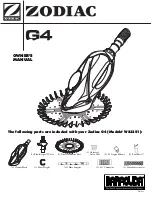
Page 4
Figure 4. Proper Design For Sediment Trap / Drip Leg
2C-2. Combustion and Ventilation Air
Supply
All indoor installations must have openings to
outside air for combustion and ventilation. Tables 1
and 2 (see Fig. 3) show the net free opening areas
required at both ceiling and floor for the different
heater sizes. Waterpik Technologies does not recom-
mend indoor installations that do not provide combus-
tion air from outside the building.
NOTE:
Check with louver manufacturers for Net
Free Area of louvers. Correct for screen resistance to
the Net Free Area if a screen is installed. Check all
local codes applicable to combustion air.
If the heater is installed in a residential garage,
the burners must be 450 mm above the garage floor.
See the Gas Installation Code AG601 for more infor-
mation.
Warning
The conversion of this appliance from natural
gas to propane gas, or propane to natural,
must be done by an authorized person.
Waterpik Technologies provides kits and
detailed instructions for converting the heater.
2D. Gas Supply and Piping
Heaters shipped from the factory are certified to
operate at an altitude of zero to 600 m for natural gas,
to 1500 m for propane gas. The heater rating plate is
marked for use at specific altitudes.
If the supply gas pressure is less than required,
check for undersized pipe between the meter and the
heater, a restrictive fitting, or an undersized gas meter.
Waterpik Technologies recommends the gas inlet
pipe sizes in Table 3. Check local codes for compli-
ance before installing the heater.
Table 3. Recommended Gas Inlet Pipe Sizes
Heater
Distance from the meter
Size
0 to 15 m 16 to 30 m 31 to 60 m
125
20 mm
25 mm
32 mm
175
25 mm
32 mm
32 mm
250 & 325
32 mm
32 mm
40 mm
400
32 mm
40 mm
50 mm
Install a union on the gas supply line outside the
heater jacket, including a drip leg and a manual shut-
off valve (see Fig. 4). Do not use a restrictive gas cock.
Before operating the heater, test all gas connec-
tions for leaks with a soap solution. Do not use an
open flame. Disconnect the heater and its individual
shut-off valve from the gas piping during pressure
NOTE:
For propane gas, use one size smaller pipe except
on Model 125 which requires 20 mm from 0 to 15 m.
Manual Shutoff
Valve
Gas Supply
Inlet
To
Equipment
Inlet
Union
Cap
T-Fitting
75 mm Min.
Nipple
testing if the test pressure is higher than 1/2 psig (3.7
kPa). If the test pressure is equal to or less than 1/2
psig (3.7 kPa), close the manual shut-off valve on the
heater during the piping pressure test.
If the supply gas pressure (Table 4) is less than
required, check for undersized pipe between the meter
and the heater, a restrictive fitting, or an undersized
gas meter.
Table 4. Supply Gas Pressure
Minimum
Maximum
Natural Gas
1.13 kPa
2.5 kPa
Propane Gas
2.50 kPa
3.5 kPa
NOTE: The minimum value listed for input adjustment.
Do not exceed the maximum supply pressure.
2E. Electric Wiring
The unit is fitted with a flexible electric cord and
3-pin plug for connection to a 240V 10 ampere (A)
power outlet. The power outlet must be effectively
earthed. See Figure 5 for the Model LC (Australia)
heater wiring.
NOTE:
The pool heating system must have a manual
reset high limit installed in accordance with AS2610,
Section 2.7 (see Fig. 9). Contact a local installer or
distributor.
NOTE:
No external junction box is required.
2E-1. Auxiliary Time Clock Wiring
If you install a time clock to control the filter
pump operation, the clock should have its own low
voltage (Fireman's) switch that turns off the heater
before turning off the pump. The switch should shut
off the heater about 15 minutes before the filter pump
shuts off.







































